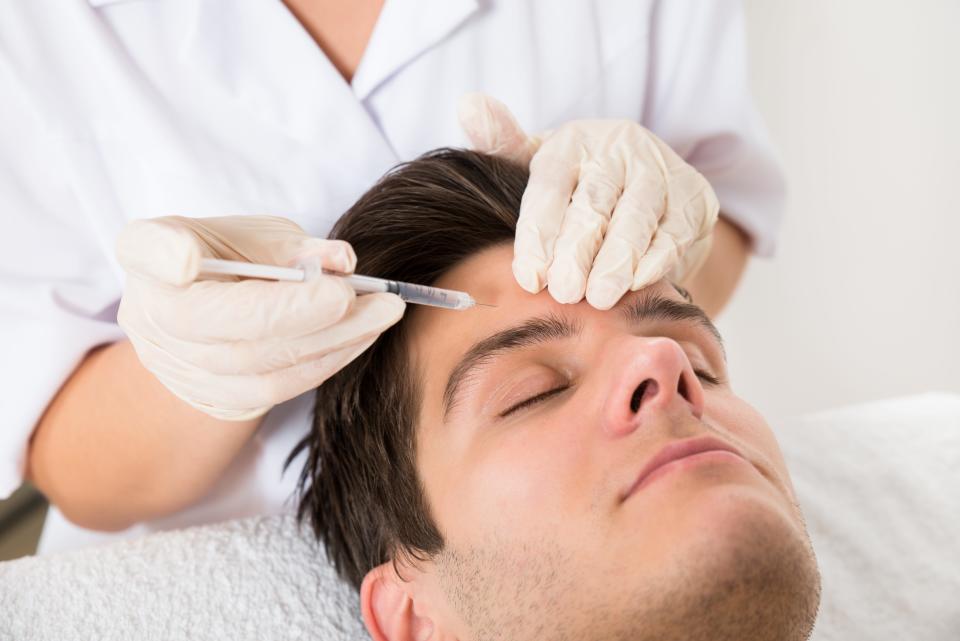What is 'Brotox'? Why men are going all in on Botox
Many people grow frustrated over forehead wrinkles as they age. That's why millions of people in the U.S. have opted for wrinkle-reducing measures like Botox to appear younger. Healthier. More vibrant.
And contrary to popular belief, it's not just women seeking these treatments. Men are too: In 2020 alone, more than 265,000 men received botulinum toxin (Botox) treatments, according to the American Society of Plastic Surgeons. Not to mention that the hashtag #Brotox has 18.5 million views on TikTok.
No one should be surprised about men's interest in Botox, experts say, as they have more openly embraced an interest in skincare and beauty trends.
"(Men) should not be embarrassed to take care of themselves, and this includes aesthetic procedures," says dermatologist Dr. Anthony Rossi. "These antiquated gender roles are being sunsetted."

What is in Botox?
What is Botox, exactly? It's a toxin: a fluid injected into a muscle that paralyzes it. It serves purposes beyond reducing wrinkles, including the treatment of neck spasms, sweating, migraines and lazy eye, according to the Mayo Clinic. It may qualify for insurance coverage for medical reasons, though otherwise typically comes with a price tag of more than $400.
Several different brands beyond Botox are on the market now; those seeking to reduce lines and wrinkles usually target the areas between the eyebrows, the forehead and around the eyes, according to dermatologist Dr. Bruce Brod. "These lines become more prominent over time and are typically lines that are accentuated with facial expression."
Botox for men: 'Now the stigma's gone'
From makeup to fashion, American men have taken a page from traditionally more feminine aesthetics (though it very much depends on which culture and century we're talking about).
"Before it was considered a feminine kind of treatment, and now the stigma's gone," says Dr. Randa Jaafar, New York-based anesthesiologist and pain management physician and owner of the FILD studio. She started offering Botox for pain conditions, then went a cosmetic route too.
She says men come in, dragged by their wives, terrified they might look like they had a terrible facelift after an injection. But once they go through with the procedure and watch the line in their forehead disappear, they come crawling back every three months.
"I had a male patient years ago who said he knew it was time to come in for Botox when his wife started to ask him why he was scowling at her," says New York City dermatologist Dr. Dina Strachan.
Brod sees a wide variety of his clientele seeking injections. "My patients of all genders often choose injections with these toxins to enhance their facial appearance so they look younger," Brod says. "This can boost confidence and give them a more rested, relaxed and friendlier appearance. People are living and working longer and want to maintain a more youthful appearance."
Is it worth it? ‘Barbie Botox’ trend has people breaking the bank to make necks longer
Botox misconceptions
Common misconceptions loom about the procedure. "Most of my patients inquiring about the use of botulinum toxins for the first time are concerned they will look expressionless or surprised or unnatural," Brod says. It takes about 10 days post-injection to notice results, and men usually require more of the toxin.
"I often say the best thing and the worst thing about botulinum toxin is that its effect is temporary," Brod adds. "This is reassuring because if they do not like the result they just need to wait a few months. On the other hand, most patients are very happy with the results and need to repeat the treatments every three to six months."
Also, not just anyone can pull out a needle and start administering it. "It is important for the patient to be fully aware of the level of training, licensure and experience of the professional performing the procedure," Brod says.
Men may be self-conscious about Botox from a masculinity standpoint. But it's not just men who are self-conscious. Everyone is concerned about how they age, have aged, or will age.
"I expect it to be more accepted with time in general as people often start using it in their 20s these days," Strachan adds. "I find the older people who it was originally targeted at (are) more self-conscious about it than the younger people."
Patients should chat with their doctors about their reasons for seeking treatment. "Everyone has different aesthetic goals and it’s important to maintain one's individuality when doing these procedures," Rossi says.
Above all, though, men shouldn't be embarrassed for seeking out Botox (nor anyone). Rossi adds: "I think of it as maintaining skin health and wellness just like working out your muscles at the gym."
Interesting: Young people are documenting, recording their plastic surgery on TikTok. Here’s why that’s a bad thing.
This article originally appeared on USA TODAY: What is Botox for men: 'Brotox' face, cost and male beauty trends

